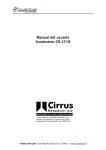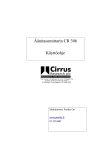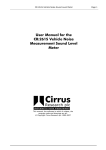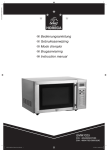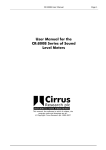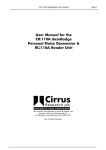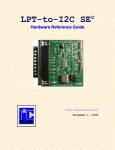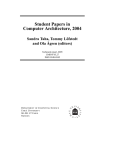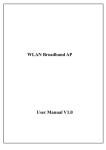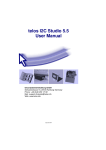Download IRD User Manual
Transcript
IRD User Manual telos Systementwicklung GmbH Schlueterstrasse 16, 20146 Hamburg /Germany Phone: +49 (0)40 450 173 61 Mail: [email protected] Web: www.telos.info July 17, 2013 Contents 1 Introduction 4 2 XML Header 4 3 IRD Structure 4 4 Header 4.1 Introduction . . . . . . . . . . . . 4.2 I2C Addresses . . . . . . . . . . . 4.2.1 Single Address . . . . . . 4.2.2 Address Range . . . . . . 4.3 Manufacturer . . . . . . . . . . . 4.4 Name . . . . . . . . . . . . . . . . 4.5 Description . . . . . . . . . . . . . 4.6 Sub Address . . . . . . . . . . . . 4.7 Auto Increment . . . . . . . . . . 4.8 Bus Type . . . . . . . . . . . . . . 4.9 Unique Device Identifier (UDID) . . . . . . . . . . . . . . . . . . . . . . . . . . . . . . . . . . . . . . . . . . . . . . . . . . . . . . . . . . . . . . . . . . . . . . . . . . . . . . . . . . . . . . . . . . . . . . . . . . . . . . . . . . . . . . . . . . . . . . . . . . . . . . . . . . . . . . . . . . . . . . . . . . . . . . . . . . . . . . . . . . . . . . . . . . . . . . . . . . . . . . . . . . . . . . . . . . . . . . . . . . . . . . . . . . . . . . . . . . . . . . . . . . . . . . . 5 5 6 6 6 6 7 7 7 8 8 8 5 Register 5.1 Introduction . . . . . . . . . . . . . . . . . . . 5.2 Identifier . . . . . . . . . . . . . . . . . . . . . 5.3 Sub Addresses . . . . . . . . . . . . . . . . . . 5.4 Format . . . . . . . . . . . . . . . . . . . . . . 5.4.1 Quick Command . . . . . . . . . . . . 5.4.2 Send/Receive Byte . . . . . . . . . . . 5.4.3 Empty . . . . . . . . . . . . . . . . . . 5.4.4 Write/Read Byte/Word/DWord . . . 5.4.5 Process Call . . . . . . . . . . . . . . . 5.4.6 Block Write/Read . . . . . . . . . . . . 5.4.7 Block Write - Block Read Process Call 5.5 Name . . . . . . . . . . . . . . . . . . . . . . . 5.6 Power-On Reset . . . . . . . . . . . . . . . . . . . . . . . . . . . . . . . . . . . . . . . . . . . . . . . . . . . . . . . . . . . . . . . . . . . . . . . . . . . . . . . . . . . . . . . . . . . . . . . . . . . . . . . . . . . . . . . . . . . . . . . . . . . . . . . . . . . . . . . . . . . . . . . . . . . . . . . . . . . . . . . . . . . . . . . . . . . . . . . . . . . . . . . . . . . . . . . . . . . . . . . . . . . . . . . . . . . . . . . . . . . . . . . . . . . . . . . . . . . . . . . . . . . . . . . . . . . . . . . . . . . . . . . . . . . . . . . . . . . . . 9 9 9 9 9 9 10 10 10 10 11 11 11 11 6 Types 6.1 Introduction . . . . . 6.2 Integer Types . . . . 6.2.1 type int . . . 6.2.2 type int value 6.2.3 Examples . . 6.3 ASCII Types . . . . . 6.4 String Types . . . . . . . . . . . . . . . . . . . . . . . . . . . . . . . . . . . . . . . . . . . . . . . . . . . . . . . . . . . . . . . . . . . . . . . . . . . . . . . . . . . . . . . . . . . . . . . . . . . . . . . . . . . . . . . . . . . . . . . . . . . . . . . . . . . . . . . . . . . . . . . . . 11 11 12 12 13 13 14 14 . . . . . . . . . . . . . . . . . . . . . . . . . . . . . . . . . . . . . . . . . . . . . . . . . . . . . . . . . . . . . . . . . . . . . . . . . . . . . . . . . . . . . . . . . . . . . . . . . . . . . . . 2 . . . . . . . . . . . . . . . . . . . . . . . . . . . . . . . . . . . . . . . . . . . . . . . . . . . . . . . . . . . . . 7 Values 7.1 value . . 7.2 source . . 7.3 type . . . 7.4 Examples . . . . . . . . . . . . . . . . . . . . . . . . . . . . . . . . . . . . . . . . . . . . . . . . . . . . . . . . . . . . . . . . . . . . 8 Example . . . . . . . . . . . . . . . . . . . . . . . . . . . . . . . . . . . . . . . . . . . . . . . . . . . . . . . . . . . . . . . . . . . . . . . . . . . . . . . . . . . . . . . . . . . . . . . . 15 15 15 16 16 18 3 1 Introduction A bus tracer is able to display low level information like register addresses and read or written data only. Thus, a user must check the IC specification for advanced information if the meaning of the register data is not evident. To handle this constraint, telos invented a register description language for I2C and SMBus ICs. This language helps to transform manufacturer data sheets and design specifications into a XML-based file. This allows a tracer application software like telos I2C Studio to display high level information about IC registers and their mode of operation. No knowledge of programming languages is needed to write IRD files. The following article gives a brief introduction into the creation of IRD files. For unapproved users telos provides an IRD File Creation Service for any desired IC. Please feel free to ask for further information. 2 XML Header Each IRD file starts with the following XML header: <?xml version="1.0" encoding="utf-8"?> <device xsi:schemaLocation="http://www.telos.de/namespace/ird ird.xsd" xmlns:xsi="http://www.w3.org/2001/XMLSchema-instance" xmlns="http://www.telos.de/namespace/ird"> This header defines the used character encoding and file format. UTF-8 is the 8 bit Unicode Transformation Format for character encoding. In contrast to the ASCII encoding UTF-8 supports all characters of the Unicode standard. The first part of the UTF-8 code [0,..,127] is equal to ASCII. For a full UTF-8 support it is necessary to use an editor which supports this encoding. IRD files have to be stored with the extension ”.xml”. 3 IRD Structure All elements of an IRD file, except for the XML header mentioned above, must be placed between the following two identifiers: <device xsi:schemaLocation="http://www.telos.de/namespace/ird ird.xsd" xmlns:xsi="http://www.w3.org/2001/XMLSchema-instance" xmlns="http://www.telos.de/namespace/ird"> <!-<!-- Header <!-- --> --> --> (...) <!-- --> 4 <!-- Registers <!-- --> --> (...) <!-<!-- Types <!-- --> --> --> (...) <!-<!-- Values <!-- --> --> --> (...) </device> There are four groups of elements in an IRD file: Header The header keeps some information about the IC. E.g. this group contains the names of the manufacturer and the IC. Registers The IC’s registers are defined here. Types Like in normal programming languages it is possible to define types. E.g. this can be used to define a type for boolean or enumerations. Values A value interprets the content of registers or parts of them. The groups should be marked with a comment string to keep the file well arranged. A comment can be placed between a start <!-- and an end --> tag. 4 Header 4.1 Introduction A typical header is as follows: <i2c_addresses> <i2c_address address="0x4c" ten_bit="false" /> </i2c_addresses> <manufacturer>telos Systementwicklung GmbH</manufacturer> <name>TEL 4711</name> <description>Test IC for IRD Files</description> <sub_addr width="byte" /> <auto_inc inc="true" /> <bus_type type="i2c" /> 5 4.2 I2C Addresses ICs supporting the I2C or SMBus protocol get addressed by their slave address. Some ICs have got a fix address. Other ICs support several addresses. Typically the designer of the PCB configures the address to be used by wiring some pins of the IC. In the IRD header the user can specify, which addresses are supported by an IC. All addresses have to be specified within the <i2c addresses> element. The author of an IRD file can list each supported I2C address separately. Another way is to specify a range of supported addresses. Note: An IRD file describes an IC and has to be kept independent from a certain PCB. Thus all possible I2C bus addresses should be listed in the IRD file and not only these addresses, which are used ”physically” on a special hardware platform. 4.2.1 Single Address An IC supporting the addresses 0x50 and 0x52 (both in the 7 bit address format) would define these addresses like this in the header: <i2c_addresses> <i2c_address address="0x50" ten_bit="false" /> <i2c_address address="0x52" ten_bit="false" /> </i2c_addresses> The element <i2c address> has got two attributes. The address gets specified using the address attribute. It is possible to specify 7 bit and 10 bit addresses. When an IC uses a 10 bit address, the author has to set the ten bit attribute to true. For 7 bit addresses this attribute can be set to false. 4.2.2 Address Range Some ICs support a lot of slave addresses. For these ICs it would be inefficient to specify all addresses separately. Therefore it is possible to specify complete ranges of I2C addresses. The following example shows how to define an address range from 0x60 to 0x70: <i2c_addresses> <i2c_address_range start_address="0x60" start_address_ten_bit="false" stop_address="0x70" stop_address_ten_bit="false" /> </i2c_addresses> An address range uses the element <i2c address range>. This first address of the range is specified using the attributes start address and start address ten bit. The last address gets defined by the attributes stop address and stop address range. 4.3 Manufacturer The name of the manufacturer can be defined with the <manufacturer> element. 6 4.4 Name All type of ICs on the market have got a name to identify the IC. E.g. the widely used I2C RAM from NXP has got the name ”PCF8570”. The name can be set with the <name> element. 4.5 Description The <description> element describes the functionality of an IC for the user. For the ”PCF8570” this could look like this: ”256 x 8-bit static low-voltage RAM with I2C-bus interface”. 4.6 Sub Address Almost any I2C IC uses an address pointer to specify, which register should be read or written. SMBus ICs use a similar feature called ”Command Byte”. This address pointer is stored in the IC. It is set by the first bytes of a master transmitter transfer on the bus. Start [S] Address Write Sub Address Stop [P] Data Figure 1: Writing to Register The typical transfer on the I2C bus to write one data byte to a register of an I2C slave is shown in figure 1. A start message [S] is followed by a device address. The LSB of the device address is an identifier for the direction (transmit, TX). The register sub address specifies the slave device’s register in which the data has to be stored after being transmitted. The message ends with a stop message [P]. Start [S] Address Write Sub Address Start [S] Address Read Data Stop [P] Figure 2: Reading from Register If data has to be read from a slave device’s register, the I2C message looks different. Figure 2 shows such a transfer. The first part of the message is transmitted to specify the address pointer. A restart message [S] marks the second part of the message. The second message contains the same slave address as the first one, but the direction gets changed (receive, RX). The address is followed by the current content of the register and the stop message [P]. As the concept of sub addresses is not part of the I2C standard itself, not all ICs are using exactly the same format for the address pointers. So the format of an IC has to be specified in the IRD header: <sub_addr width="word" byte_ordering="little"/> This IC would use a 16 bit address pointer with a little endian byte ordering. The <sub addr> element knows the following attributes: Identifier width byte ordering Setting byte word (only for I2C) little big (only when width=word) 7 4.7 Auto Increment A typical feature for I2C ICs is the automatic address pointer increment after transmission of each data byte. Start [S] Address Write Sub Address = 0x00 Data = 0x01 Data = 0x02 Data = 0x03 Stop [P] Figure 3: Writing with Auto Increment The I2C message shown in figure 3 is transmitted to a slave with the device address 0x50. If the slave supports auto increment, the first data is stored in a register at sub address 0x00. Then the register pointer is automatically incremented to the next register sub address 0x01. Thus the following data is stored in the registers after the transmission has been completed: Register 0x00 0x01 0x02 Data 0x01 0x02 0x03 After the message has been transferred completely the sub address pointer is finally set to the register at sub address 0x04. An address overflow during increment will normally cause a wrap around to the start address 0x00. Without auto increment support, the sub address pointer must be incremented manually to prevent registers from being overwritten. Whether an IC supports auto increment or not gets specified in the IRD header using the <auto inc> element, which has the attribute inc. This can be set to true or false. The following example enables auto increment: <auto_inc inc="true"/> 4.8 Bus Type At the moment the bus types I2C and SMBus are supported. The I2C bus type is configured as follows: <bus_type type="i2c" /> The SMBus provides the additional feature of ”Packet Error Checking” (PEC), which can be enabled or disabled using the pec attribute. The following example enables SMBus with PEC: <bus_type type="smb" pec="true"/> 4.9 Unique Device Identifier (UDID) The SMBus defines an ”Address Resolution Protocol” (ARP). This protocol allows an ARP master to assign addresses to slaves. Part of this protocol is the ”Unique Device Identifier” (UDID). The element <udid> can be used to specify the vendor and device IDs of an IC. These IDs are part of the UDID. The following example shows how to define the IDs: 8 <udid vendor_id="0x1020" device_id="0x0001" /> 5 Register 5.1 Introduction A register describes the physical layer of an IC. In the IRD file the register definition specifies the register sub address(es), the format, an user readable name, and the POR value. No interpretation of the content stored in the registers is done. A register is defined using the <register> element. This element has got a number of attributes, which describe each register. A typical register definition in IRD looks like this: <register id="SEC" sub_addr_read="0x00" sub_addr_write="0x00" format="byte" name="Seconds" por="0x00"/> 5.2 Identifier An unique identifier has to be assigned to each register. This identifier is used by other elements to reference registers. The attribute id is used to specify this identifier. 5.3 Sub Addresses The attributes sub addr read and sub addr write specify the sub addresses of the register for read and write transfers. Some ICs are not using the same sub address for read and for write transfers. In such cases both values are different. Some registers are read- or write-only. To implement e.g. a read-only register, simply do not specify the sub addr write attribute. 5.4 Format Different types of data can be stored in a register. E.g. the data of a register can consist of 8 or 16 bits. Using the format attribute it is possible to specify the data type of a register. 5.4.1 Quick Command The Quick Command is part of the SMBus specification. As shown in figure 4 this type of message does not contain any data bytes. The read/write bit can be used to signal a state. Start [S] Address R/W Stop [P] Figure 4: Quick Command 9 This format can be selected by setting format="quick cmd". 5.4.2 Send/Receive Byte Some simply ICs do not implement real registers. Instead they can simply send or receive one single byte. This is shown in figure 5. Start [S] Address R/W Stop [P] Data Figure 5: Send/Receive Byte This format can be selected by setting format="send receive byte". 5.4.3 Empty Some ICs specify registers, which does not contain any data bytes. Such registers are used to trigger e.g. an A/D converter. These registers allow write transfers only. Such a transfer is shown in figure 6. Start [S] Address Write Stop [P] Sub Address Figure 6: Empty This format can be selected by setting format="empty". 5.4.4 Write/Read Byte/Word/DWord Registers with a width of one byte, word, or dword can be specified by setting format to byte, word, or dword. Start [S] Address Write Sub Address Data ... Data Stop [P] Figure 7: Write Byte/Word/DWord Start [S] Address Write Sub Address Start [S] Address Read Data ... Data Stop [P] Figure 8: Read Byte/Word/DWord The transfers to such registers look like as shown in the figures 7 and 8. 5.4.5 Process Call The Process Call is a special transfer specified in the SMBus specification. It is shown in figure 9. This format can be enabled by setting format="smb pc". 10 Start [S] Address Write Sub Address Data Start [S] Data Address Data Data Read Stop [P] Figure 9: Process Call 5.4.6 Block Write/Read Another special SMBus transfer type is the block transfer, which is shown in the figures 10 and 11. This mode allows the slave to tell that master how many bytes should be read from the slave. Start [S] Address Write ... Data Byte Count Sub Address Data Stop [P] Figure 10: Block Write Start [S] Address Write Sub Address Start [S] Address Data Byte Count Read ... Data Stop [P] Figure 11: Block Read Registers using this type must set format="smb block". 5.4.7 Block Write - Block Read Process Call The Block Write - Block Read Process Call is a combination of the Process Call and the Block Read commands. This looks like in figure 12. Start [S] Address Write Sub Address Start [S] Address Read Byte Count Data Byte Count Data ... Data ... Data Stop [P] Figure 12: Block Write - Block Read Process Call It can be enabled by setting format="smb block pc". 5.5 Name The Name attribute contains a user-readable description of the register. 5.6 Power-On Reset After the reset most ICs have got a defined content in the registers. If these values are known, they can specified using the por attribute. 6 Types 6.1 Introduction As we will set later in this document the user can create a high level interpretation of the content, which is stored in the IC’s registers. For this interpretation types are needed. 11 The IRD file format knows three different classes of types: integer types, ASCII types, and string types. 6.2 Integer Types An integer type looks typically like this: <type_int id="uint8_type" width="byte" start_range="0" stop_range="255" signed="false" /> <type_int id="bool_type" width="byte" start_range="0" stop_range="1" signed="false"> <type_int_value value="1" name="True" /> <type_int_value value="0" name="False" /> </type_int> The first part defines an 8 bit unsigned value, the second defines a boolean value. 6.2.1 type int An integer type is defined using an <type int> element. This element can have the following attributes: Identifier The attribute id specifies an unique identifier, which is used to reference this type later in the value section. Width A type can have a width of one byte, word, or dword. This can be specified using the width attribute. Allowed values for this attribute are: byte, word, and dword. Range The value range of the type is specified by the attributes start range and stop range. Signed An integer type can be signed or unsigned. A type with signed="true" gets interpreted as signed, a type with signed="false" as unsigned. Divider In some cases the visualized value must be calculated by dividing the transmitted value by some divider. This can be done using the divider attribute. If the divider is set e.g. to ”2”, the value ”1” gets visualized as ”0.5”. Formula Formula to convert ransmitted values to visualized values. The formula can be set using the formula attribute. The variable ”x” is used in the formula for the transmitted value. If the formula is set e.g. to ”x*2.1+0.5”, the value ”1” gets visualized as ”2.6”. 12 6.2.2 type int value The integer type allows to assign names to specific values. This can be useful, because very often special values have got a specific meanings. E.g. for a boolean type the ”1” should be visualized as ”True” and the ”0” as ”False”. The assignment can be defined in the IRD file using the <type int value> element. This element must be specified within an <type int> element. The following attributes can be specified: Value The value to which the name should be assigned is defined by the value attribute. Value Stop Sometimes the same name should be assigned to a range of values. The start of this range is defined by value and the end by value stop. This can be useful e.g. to mark unused or illegal values. Name The name shown to the user is specified by the name attribute. 6.2.3 Examples Here are some additional examples how to define a type: 1. In the following example a frequency byte type is defined. Each value of the type has a special meaning. Thus, for every single value [0,...,3] of the range the value representation is given by a chosen name. This is a typical 2 bit type often found in IC specifications: <type_int id="frequency_type" width="byte" start_range="0" stop_range="3" signed="false"> <type_int_value value="0" name="Frequency: <type_int_value value="1" name="Frequency: <type_int_value value="2" name="Frequency: <type_int_value value="3" name="Frequency: </type_int> 1" /> 4096" /> 8192" /> 32768" /> 2. The following example demonstrates the use of the divider attribute. Let’s assume a temperature IC, which uses a 16 bit register to describe a temperature range [-128, 127.996]. The MSB byte is used to define the digits before a decimal point and the LSB byte is used to describe the digits after the decimal point: Temperature + 127.996 + 0.5 - 0.5 - 128 MSB Bits 0111 1111 0000 0000 1111 1111 1000 0000 LSB Bits 1111 1111 1000 0000 1000 0000 0000 0000 The IRD type for this purpose would look like this: 13 Hex 7F FF 00 80 FF 80 80 00 <type_int id="temp_type" width="word" start_range="-32768" stop_range="32767" signed="true" divider="256" /> 3. The following IRD type defines a signed 8-bit value: <type_int id="int8_type" width="byte" start_range="-128" stop_range="127" signed="true" /> 6.3 ASCII Types ASCII types can be defined by using the <type ascii> element. This element has got only one possible attribute: a unique ID, which is used to reference this type later in the value section. This ID gets specified by the id attribute. The characters, which can be used for an ASCII type, must be specified by at least one <type ascii range> element within the <type ascii> element. This element has got two attributes. start defines the start and stop defines the stop of the range. The following example defines the type ”ascii type”, which allows the complete range of ASCII character from ”0” to ”127”: <type_ascii id="ascii_type"> <type_ascii_range start="0" stop="127"/> </type_ascii> 6.4 String Types The element <type string> can be used to define string types. The following attributes are available for this element: Identifier The attribute id specifies an unique identifier, which is used to reference this type later in the value section. Maximum Length The maximum allowed length for this string must be set using max length. Allowed ASCII The characters, which are allowed to be used within this string type, must be set by the allowed ascii attribute. The value of this attribute must be the ID of an ASCII type. The following example defines a type with the name ”string type”, which has a maximum length of 13 characters and which is allowed to use the complete range of ASCII characters: 14 <type_ascii id="ascii_type"> <type_ascii_range start="0" stop="127"/> </type_ascii> <type_string id="string_type" max_length="13" allowed_ascii="ascii_type"/> 7 Values In section 5 of this document we have already learned something about the low level interpretation within the IRD format: the registers. This interpretation gives each register a user-readable name, but the user still has to interpret the content of the registers himself. This is where the high level interpretation of IRD comes into the game: the values. One value must not necessarily be mapped to one register. Instead, it is not uncommon that e.g. one 8 bit register is mapped to eight 1 bit values. A value consists always of one type and at least one bit from one register. It is also possible to interpret bits from different registers for one value. 7.1 value The element <value> defines a value. The following attributes are available: Identifier The attribute id specifies a unique identifier. Name A user-readable name describing the content of a value can be set with the name attribute. A typical name for e.g. a TV-set could be ”Volume”. Direction Some values are write- or read-only. This can be configured using the direction attribute, which can be set to rw, ro, or wo. 7.2 source The <source> element specifies, which bits of which registers should be interpreted by a value. The following attributes are available: Register The identifier of the register to be used gets specified by the register attribute. Start Byte The first byte from the register to be used is specified by the start byte attribute. The counting starts with ”0”. Stop Byte The last byte from the register to be used is specified by the stop byte attribute. The counting starts with ”0”. Start Bit The first bit of the start byte is specified by the start bit attribute. The counting starts with ”0” and ends with ”7”. Stop Bit The last bit of the last byte is specified by the stop bit attribute. The counting starts with ”0” and ends with ”7”. 15 7.3 type The <type> element defines how to visualize the data of the registers. The following attributes are available: Name The type to be used for the interpretation gets defined by the name attribute. An identifier of a type has to be used as value for this attribute. Offset It is possible to substract a value from the data, before passing the data to the type for interpretation. This offset is given by the offset attribute. Signed If signed is set to true, the data of the registers is interpreted as 2-complement. Unit The unit of the value can be specified by unit. This attribute can be set e.g. to ”mV”. BCD If the data in the register uses BCD, bcd can be set to true. 7.4 Examples To understand all the possibilities of the values in IRD it is the best to use some examples. 1. A typical value definition for one single bit is given as: <value name="Shutdown" direction="rw"> <source register="CONF" start_bit="0" stop_bit="0" /> <type name="shutdown_type" /> </value> This value is called ”Shutdown” (freely chosen name) and is a single bit (bit 0) in a register with the register ID ”CONF”, defined in the register part of the IRD file. The bit can be read or written, thus, the data direction is ”rw”. The type ”shutdown type” must be defined in the type declaration part of the IRD file. 2. A group of bits in one register is defined: <value name="Supply" direction="rw"> <source register="CONF" start_bit="1" stop_bit="5" /> <type name="supply_type" /> </value> The bits 1 to 5 of the CONF register are used. 3. Sometimes a group of bits is defined across register borders: <value name="Alarm Flag" direction="rw"> <source register="AL_SEC" start_bit="7" stop_bit="7" /> <source register="AL_MIN" start_bit="7" stop_bit="7" /> <source register="AL_HOUR" start_bit="7" stop_bit="7" /> <source register="AL_DAY" start_bit="6" stop_bit="7" /> <type name="alarm_flag_type" /> </value> 16 This value is defined by a group of 5 bits across 4 registers. 4. A value using a complete register can be defined as: <value name="Year" direction="rw"> <source register="YEAR" /> <type name="year_type" /> </value> No start and stop bit attributes are necessary here. 5. A BCD interpretation of the register can be defined as: <value name="Month" direction="rw"> <source register="MON" start_bit="0" stop_bit="4" /> <type name="month_type" bcd="true" /> </value> 6. If the register is interpreted as a value with a unit, a unit name can be freely defined: <value name="Minutes" direction="rw"> <source register="MIN" start_bit="0" stop_bit="6" /> <type name="time_type" unit="min" bcd="true" /> </value> The register value is defined as a ”time type” and the data is interpreted as ”minutes”. Thus, the unit ”min” could clarify the interpretation. 7. Sometimes the IC supports a byte order, which is not part of the bus standard. In this case the bytes must be sorted ”by hand” in the value definition: <value name="Temperature" direction="ro"> <source register="TEMP" start_byte="1" stop_byte="1" start_bit="3" stop_bit="7" /> <source register="TEMP" start_byte="0" stop_byte="0" /> <type name="temp_type" unit="◦ C" signed="true" /> </value> The register ”TEMP” is a word register with bits 3 to 15 used for temperature information. The SMBus standard defines a data transmission (Write Word protocol) which is byte-oriented. To follow the standard the first byte to be transmitted must be the LSB byte (bit 3 - 7) of the register word, and the second byte must be the MSB byte (word bit 8 - 15, byte bit 0 - 7) of the register word. The manufacturer now defines a ”Write Word” format which swaps the byte order. Thus, the MSB byte is transmitted first. Therefore it is necessary to redefine the byte order in the value definition. The first byte (byte 0) to be received is the MSB byte (bit 0 - 7) of the IC register, the second byte (byte 1) to be received is the LSB byte (bit 3 - 7) of the IC register. To change the byte order the byte 1 of the receive buffer is mentioned first in the source register list to be marked as LSB. The byte 0 in the buffer is mentioned in second place to mark this as MSB. 17 8 Example The following examples contains a complete IRD file for the ”LM 75” temperature sensor from National Semiconductors: <?xml version="1.0" encoding="utf-8"?> <device xsi:schemaLocation="http://www.telos.de/namespace/ird ird.xsd" xmlns:xsi="http://www.w3.org/2001/XMLSchema-instance" xmlns="http://www.telos.de/namespace/ird"> <!---> <!-Header --> <!---> <i2c_addresses> <i2c_address_range start_address="0x48" start_address_ten_bit="false" stop_address="0x4F" stop_address_ten_bit="false" /> </i2c_addresses> <manufacturer>National Semiconductor</manufacturer> <name>LM 75</name> <description>Digital Temperature Sensor and Thermal Watchdog with Two-Wire Interface</description> <device_type>Temperature Sensor</device_type> <sub_addr width="byte" /> <auto_inc inc="true" /> <bus_type type="i2c" /> <!---> <!-Registers --> <!---> <register id="temp" sub_addr_read="0x00" format="word" name="Temperature" /> <register id="config" sub_addr_read="0x01" sub_addr_write="0x01" format="byte" name="Configuration" por="0x00" /> <register id="t_hyst" sub_addr_read="0x02" sub_addr_write="0x02" format="word" name="T_HYST" por="0x4b" /> <register id="t_os" sub_addr_read="0x03" sub_addr_write="0x03" format="word" name="T_OS" por="0x50" /> <!---> <!-Types --> 18 <!---> <type_int id="config_fault_type" width="byte" start_range="0" stop_range="3" signed="false"> <type_int_value value="0" name="1" /> <type_int_value value="1" name="2" /> <type_int_value value="2" name="4" /> <type_int_value value="3" name="6" /> </type_int> <type_int id="config_pol_type" width="byte" start_range="0" stop_range="1" signed="false"> <type_int_value value="0" name="O.S.: Active Low" /> <type_int_value value="1" name="O.S.: Active High" /> </type_int> <type_int id="config_op_mode_type" width="byte" start_range="0" stop_range="1" signed="false"> <type_int_value value="0" name="Comparator Mode" /> <type_int_value value="1" name="Interrupt Mode" /> </type_int> <type_int id="config_shutdown_type" width="byte" start_range="0" stop_range="1" signed="false"> <type_int_value value="0" name="Active Mode" /> <type_int_value value="1" name="Shutdown Mode" /> </type_int> <type_int id="temp_type" width="word" start_range="-110" stop_range="250" signed="true" divider="2" /> <!---> <!-Values --> <!---> <value id="value__temperature" name="Temperature" direction="ro"> <source register="temp" start_byte="1" stop_byte="1" start_bit="7" stop_bit="7"/> <source register="temp" 19 start_byte="0" stop_byte="0" start_bit="0" stop_bit="7"/> <type name="temp_type" unit="◦ C" signed="true" /> </value> <value id="value__fault_queue" name="Fault Queue" direction="rw"> <source register="config" start_bit="3" stop_bit="4" /> <type name="config_fault_type" /> </value> <value id="value__os_polarity" name="O.S. Polarity" direction="rw"> <source register="config" start_bit="2" stop_bit="2" /> <type name="config_pol_type" /> </value> <value id="value__comparator_interrupt_mode" name="Comparator/Interrupt Mode" direction="rw"> <source register="config" start_bit="1" stop_bit="1" /> <type name="config_op_mode_type" /> </value> <value id="value__shutdown" name="Shutdown" direction="rw"> <source register="config" start_bit="0" stop_bit="0" /> <type name="config_shutdown_type" /> </value> <value id="value__t_hyst" name="T_HYST" direction="rw"> <source register="t_hyst" start_byte="1" stop_byte="1" start_bit="7" stop_bit="7"/> <source register="t_hyst" start_byte="0" stop_byte="0" start_bit="0" stop_bit="7"/> <type name="temp_type" unit="◦ C" signed="true" /> </value> 20 <value id="value__t_os" name="T_OS" direction="rw"> <source register="t_os" start_byte="1" stop_byte="1" start_bit="7" stop_bit="7"/> <source register="t_os" start_byte="0" stop_byte="0" start_bit="0" stop_bit="7"/> <type name="temp_type" unit="◦ C" signed="true" /> </value> </device> 21






















